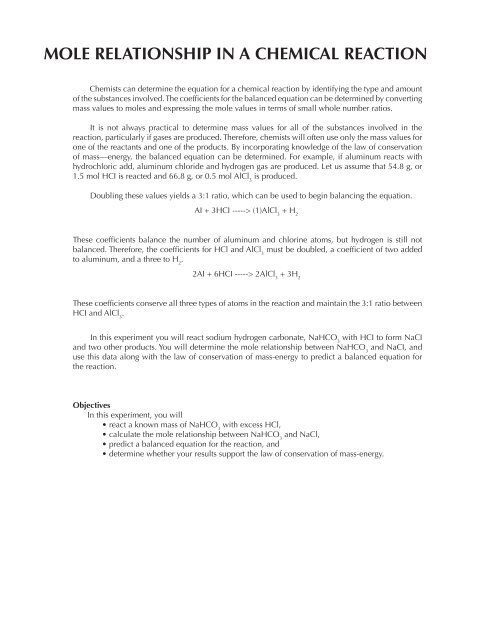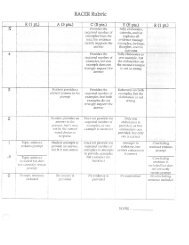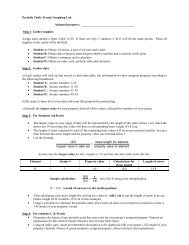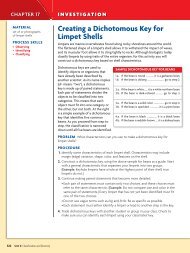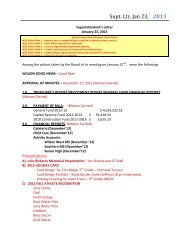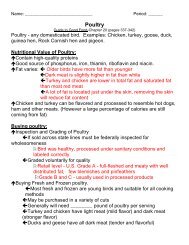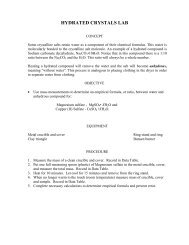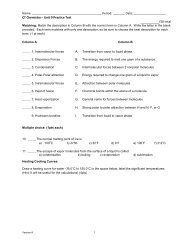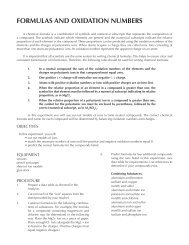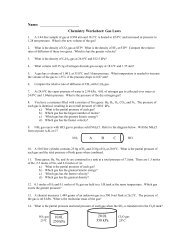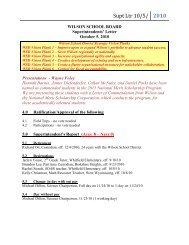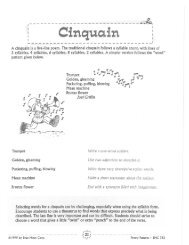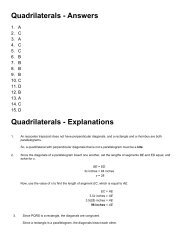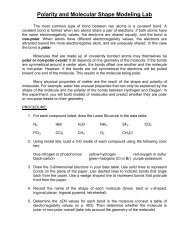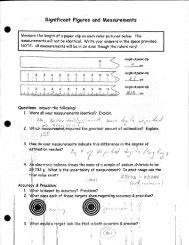Mole Relationship in a Chemical Reaction - WilsonSD.org
Mole Relationship in a Chemical Reaction - WilsonSD.org
Mole Relationship in a Chemical Reaction - WilsonSD.org
You also want an ePaper? Increase the reach of your titles
YUMPU automatically turns print PDFs into web optimized ePapers that Google loves.
MOLE RELATIONSHIP IN A CHEMICAL REACTION<br />
Chemists can determ<strong>in</strong>e the equation for a chemical reaction by identify<strong>in</strong>g the type and amount<br />
of the substances <strong>in</strong>volved. The coefficients for the balanced equation can be determ<strong>in</strong>ed by convert<strong>in</strong>g<br />
mass values to moles and express<strong>in</strong>g the mole values <strong>in</strong> terms of small whole number ratios.<br />
It is not always practical to determ<strong>in</strong>e mass values for all of the substances <strong>in</strong>volved <strong>in</strong> the<br />
reaction, particularly if gases are produced. Therefore, chemists will often use only the mass values for<br />
one of the reactants and one of the products. By <strong>in</strong>corporat<strong>in</strong>g knowledge of the law of conservation<br />
of mass—energy, the balanced equation can be determ<strong>in</strong>ed. For example, if alum<strong>in</strong>um reacts with<br />
hydrochloric add, alum<strong>in</strong>um chloride and hydrogen gas are produced. Let us assume that 54.8 g, or<br />
1.5 mol HCI is reacted and 66.8 g, or 0.5 mol AlCl 3<br />
is produced.<br />
Doubl<strong>in</strong>g these values yields a 3:1 ratio, which can be used to beg<strong>in</strong> balanc<strong>in</strong>g the equation.<br />
AI + 3HCI -----> (1)AlCl 3<br />
+ H 2<br />
These coefficients balance the number of alum<strong>in</strong>um and chlor<strong>in</strong>e atoms, but hydrogen is still not<br />
balanced. Therefore, the coefficients for HCl and AlCl 3<br />
must be doubled, a coefficient of two added<br />
to alum<strong>in</strong>um, and a three to H 2<br />
.<br />
2AI + 6HCI -----> 2AlCl 3<br />
+ 3H 2<br />
These coefficients conserve all three types of atoms <strong>in</strong> the reaction and ma<strong>in</strong>ta<strong>in</strong> the 3:1 ratio between<br />
HCI and AlCl 3<br />
.<br />
In this experiment you will react sodium hydrogen carbonate, NaHCO 3<br />
with HCI to form NaCI<br />
and two other products. You will determ<strong>in</strong>e the mole relationship between NaHCO 3<br />
and NaCI, and<br />
use this data along with the law of conservation of mass-energy to predict a balanced equation for<br />
the reaction.<br />
Objectives<br />
In this experiment, you will<br />
• react a known mass of NaHCO 3<br />
with excess HCl,<br />
• calculate the mole relationship between NaHCO 3<br />
and NaCl,<br />
• predict a balanced equation for the reaction, and<br />
• determ<strong>in</strong>e whether your results support the law of conservation of mass-energy.
Procedure<br />
1. Clean and dry an evaporat<strong>in</strong>g dish and watch glass. Measure and record their mass to the nearest 0.01g<br />
2. Weigh out approximately 2 grams of Sodium hydrogen carbonate (NaHCO 3<br />
) on weigh paper. Transfer this<br />
compound to the evaporat<strong>in</strong>g dish and record the mass of the compound, dish, and watch glass.<br />
3. Obta<strong>in</strong> about 6mL of 6M HCl <strong>in</strong> a clean graduated cyl<strong>in</strong>der. Gradually add the acid to the bak<strong>in</strong>g soda <strong>in</strong> the<br />
evaporat<strong>in</strong>g dish with a small pipet. Allow the drops to enter the lip of the dish so that they gradually flow<br />
down the side. **BE CAREFUL NOT TO SPLASH ACID ON YOUR HANDS**<br />
4. Cont<strong>in</strong>ue add<strong>in</strong>g the acid slowly until the reaction has stopped (no more gas bubbles produced). You will<br />
have to swirl the dish gently to keep the acid react<strong>in</strong>g with the NaHCO 3<br />
.<br />
5. Once all of the bak<strong>in</strong>g soda, the limit<strong>in</strong>g reactant, has been consumed, exam<strong>in</strong>e the underside of the watch<br />
glass for any particles of bak<strong>in</strong>g soda. If any particles are attached to the underside of the watch glass, r<strong>in</strong>se<br />
them <strong>in</strong>to the evaporat<strong>in</strong>g dish with a SMALL amount of distilled water.<br />
6. Heat the liquid <strong>in</strong> the evaporat<strong>in</strong>g dish GENTLY on a wire gauze/r<strong>in</strong>g stand. Cont<strong>in</strong>ue to heat gently until all<br />
of the water has evaporated.<br />
7. Wait at least 5 m<strong>in</strong>utes to allow the dish to cool. DO NOT TRY TO MOVE THE DISH UNTIL IT IS COOL!<br />
Measure and record the mass of the evaporat<strong>in</strong>g dish, watch glass, and solid product (sodium chloride).<br />
Record <strong>in</strong> the data table.<br />
8. Clean all glassware and return all lab equipment.
Name: _________________________________ Period: _________ Date: _______________________<br />
<strong>Mole</strong> <strong>Relationship</strong> <strong>in</strong> a <strong>Chemical</strong> <strong>Reaction</strong> – Data Sheet<br />
Mass of evaporat<strong>in</strong>g dish and watch glass<br />
Mass of evaporat<strong>in</strong>g dish, watch glass, and<br />
NaHCO 3<br />
Mass of NaHCO 3<br />
Mass of evaporat<strong>in</strong>g dish, watch glass, and<br />
NaCl<br />
Mass of NaCl<br />
Calculations: Show all work, units, and SigDigs!<br />
1. Calculate moles of NaHCO 3<br />
:<br />
2. Calculate moles of NaCl:<br />
3. Calculate whole number mole ratio between NaHCO 3<br />
and NaCl:<br />
______ moles NaHCO 3<br />
: ______ moles NaCl
4. Write a balanced chemical equation for the reaction of NaHCO 3<br />
and HCl:<br />
5. Us<strong>in</strong>g stoichiometry, calculate the theoretical yield of NaCl that you would expect to produce based on your<br />
start<strong>in</strong>g quantity of NaHCO 3<br />
:<br />
6. What is the % yield of NaCl (based on the quantity actually produced):<br />
7. Use your knowledge of mole ratios, oxidation numbers, and chemical formulas to solve the follow<strong>in</strong>g<br />
problem:<br />
1.46 grams of HCl was used to completely react with 3.27 grams of an unknown carbonate compound<br />
(molar mass = 327 g/mol). Determ<strong>in</strong>e the mole ratio between the carbonate compound and the HCl, then<br />
fill-<strong>in</strong> all of the blanks below.<br />
____ X(CO 3<br />
) _____<br />
+ ____ HCl --------> ____ XCl _____<br />
+ ____ H 2<br />
O + 2 CO 2


